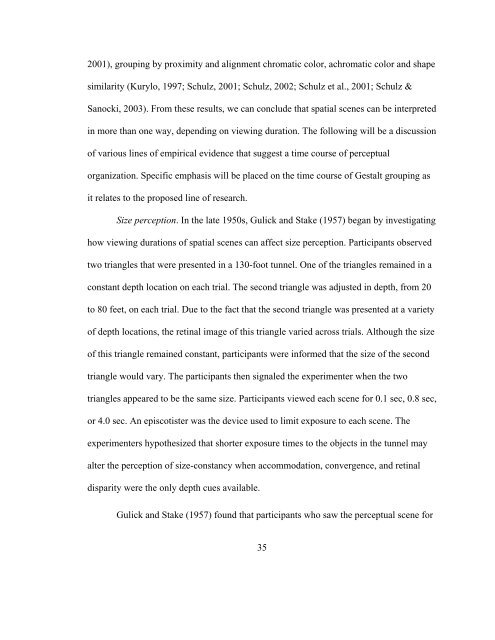The Use of Iambic Pentameter in the
The Use of Iambic Pentameter in the
The Use of Iambic Pentameter in the
Create successful ePaper yourself
Turn your PDF publications into a flip-book with our unique Google optimized e-Paper software.
2001), group<strong>in</strong>g by proximity and alignment chromatic color, achromatic color and shape<br />
similarity (Kurylo, 1997; Schulz, 2001; Schulz, 2002; Schulz et al., 2001; Schulz &<br />
Sanocki, 2003). From <strong>the</strong>se results, we can conclude that spatial scenes can be <strong>in</strong>terpreted<br />
<strong>in</strong> more than one way, depend<strong>in</strong>g on view<strong>in</strong>g duration. <strong>The</strong> follow<strong>in</strong>g will be a discussion<br />
<strong>of</strong> various l<strong>in</strong>es <strong>of</strong> empirical evidence that suggest a time course <strong>of</strong> perceptual<br />
organization. Specific emphasis will be placed on <strong>the</strong> time course <strong>of</strong> Gestalt group<strong>in</strong>g as<br />
it relates to <strong>the</strong> proposed l<strong>in</strong>e <strong>of</strong> research.<br />
Size perception. In <strong>the</strong> late 1950s, Gulick and Stake (1957) began by <strong>in</strong>vestigat<strong>in</strong>g<br />
how view<strong>in</strong>g durations <strong>of</strong> spatial scenes can affect size perception. Participants observed<br />
two triangles that were presented <strong>in</strong> a 130-foot tunnel. One <strong>of</strong> <strong>the</strong> triangles rema<strong>in</strong>ed <strong>in</strong> a<br />
constant depth location on each trial. <strong>The</strong> second triangle was adjusted <strong>in</strong> depth, from 20<br />
to 80 feet, on each trial. Due to <strong>the</strong> fact that <strong>the</strong> second triangle was presented at a variety<br />
<strong>of</strong> depth locations, <strong>the</strong> ret<strong>in</strong>al image <strong>of</strong> this triangle varied across trials. Although <strong>the</strong> size<br />
<strong>of</strong> this triangle rema<strong>in</strong>ed constant, participants were <strong>in</strong>formed that <strong>the</strong> size <strong>of</strong> <strong>the</strong> second<br />
triangle would vary. <strong>The</strong> participants <strong>the</strong>n signaled <strong>the</strong> experimenter when <strong>the</strong> two<br />
triangles appeared to be <strong>the</strong> same size. Participants viewed each scene for 0.1 sec, 0.8 sec,<br />
or 4.0 sec. An episcotister was <strong>the</strong> device used to limit exposure to each scene. <strong>The</strong><br />
experimenters hypo<strong>the</strong>sized that shorter exposure times to <strong>the</strong> objects <strong>in</strong> <strong>the</strong> tunnel may<br />
alter <strong>the</strong> perception <strong>of</strong> size-constancy when accommodation, convergence, and ret<strong>in</strong>al<br />
disparity were <strong>the</strong> only depth cues available.<br />
Gulick and Stake (1957) found that participants who saw <strong>the</strong> perceptual scene for<br />
35

















